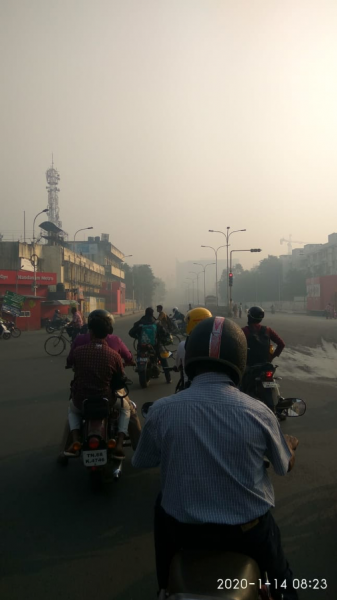As I woke up this morning, the smell of air reminded me of a morning in Delhi. What was it in Chennai’s air that made my sleepy mind think of Delhi as I woke up? The smell was familiar, and I remembered having experienced it at the same time last year in Chennai. I peeped out of my bedroom window and saw the streets filled with smoke. I grabbed my mobile and the portable air quality monitor, and I ran to the terrace. I snapped a panorama shot of the smoky skies on Chennai’s horizon while waiting for the air quality monitor to stabilise. The smudge of Sun that you see in the image below is caused by the presence of high levels of particulate matter (PM) in the atmosphere, which disperse the sunrays.
Image 1: Panoramic view of the Chennai sky at 7:00 AM from Kovilambakkam
High levels of PM cause breathing difficulty in humans. By now, the portable air quality monitor was displaying the values for formaldehyde (HCHO), total volatile organic compounds (TVOC), PM 1, PM 2.5 and PM 10. Maximum values recorded at 7:00 AM (14 Jan 2020) for HCHO and TVOC were 0.07 mg/m3 and 0.55 mg/m3, respectively. HCHO at this concentration can cause irritation of eyes and throat, while that of TVOC can cause irritation of eyes and dizziness. If you have experienced eye/throat irritation today morning, you now know the reason for it. Highest average value of PM 2.5 at 7:00am was more than 1,000 µg/m3 at 7:00 AM. The safe limit for PM 2.5 is 25 µg/m3 daily mean, according to the World Health Organization (WHO). PM 1, 2.5 and 10 all can cause respiratory problems, and smaller the size of the particle, deeper it can penetrate in our lungs and from there to different organs of the body, including the brain. Increased exposure to PM is linked to increased mortality in more ways than one. Poor visibility caused a multiple vehicle collision in Ranipet on Tuesday morning, injuring 11 persons and killing one. This news report specifies Bhogi burning as an important cause for the poor visibility. The impact of air pollution on children is the most severe as their blood pumps faster to feed their rapidly developing body. Pregnant women are at high risk too as the pollutants in air can affect the development of the foetus.
On my ride to the office today, I saw smoke and haze all along the 18 km journey (as you can see in the image below). My colleagues asked me to share the air quality readings for the morning and informed me they felt that air quality on Bhogi morning this year was worse compared to last year.

Image 2: Hazy sky and reduced visibility on road at Nandanam metro traffic signal today at 8:25 AM
The practice of burning waste on Bhogi is actually depositing the pollutants deep in our bodies. What should we care more about, the symbolic burning of material waste or getting rid of pollutants in the air? The belief is that burning waste on Bhogi leads to purification, but in reality, the entire city is choked by the smoke filling our skyline. Do we give the choice of good health to our children? If you answered yes, please pledge to celebrate a smoke-free bhogi next year and convince your family, friends and neighbours to do so as well.

